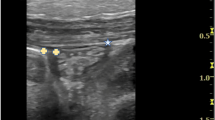Abstract
Abdominal entry at the time of laparoscopy remains the most critical step in laparoscopic surgery. Transabdominal ultrasound (TAU) and cine magnetic resonance imaging (cine-MRI) are both non-invasive tools in the preoperative prediction of adhesions. Ultrasound is effective in detecting abdominal wall adhesions, but MRI is the best for intra-abdominal adhesions. Periumbilical ultrasound-guided saline infusion (PUGSI) is an excellent method for detecting subumbilical adhesions. Evaluate the most effective and rapid method for diagnosis of subumbilical adhesions before laparoscopic interference in gynecological practice. This study was carried out on 90 high-risk patients for subumbilical adhesions. All patients were subjected to medical history, physical examination, laboratory investigations, and three techniques for subumbilical adhesions detection before laparoscopic entry including cine-MRI, TAU, and PUGSI. PUGSI for detection of subumbilical adhesions showed that the sensitivity of 94.7 % and a specificity of 90.1 %. With preoperative TAU, a sensitivity of 89.5 % and a specificity of 88.7 % were obtained. With cine-MRI, a sensitivity of 78.9 % and a specificity of 84.5 % were obtained. PUGSI is a more sensitive and rapid method than TAU and cine-MRI for detection of subumbilical adhesions before laparoscopic gynecological surgery.
Similar content being viewed by others
References
Menzies D, Ellis H (1990) Intestinal obstruction from adhesion—how big is the problem? Ann. R.Coll. Surg Engl 72:60–63
Tinelli A, Malvasi A, Guido M, Tsin DA, Hudelist G, Stark M, Mettler L (2011) Laparoscopy entry in patients with previous abdominal and pelvic surgery. Surg Innov 18(3):201–205
Tu FF, Lamvu GM, Hartmann KE, Steege JF (2005) Preoperative ultrasound to predict infraumbilical adhesions: a study of diagnostic accuracy. Am J Obstet Gynecol 192:74–79
Freys SM, Fuchs KH, Heimbucher J, Thiede A (1994) Laparoscopic adhesiolysis. Surg Endosc 8:1202–1207
Nezhat C, Cho J, Morozov V, Yeung P (2009) Preoperative periumbilical ultrasound-guided saline infusion (PUGSI) as a tool in predicting obliterating subumbilical adhesions in laparoscopy. Fertil Steril 91(6):2714–2719
Zinther NB, Fedder J, Friis-Andersen H (2010) Noninvasive detection and mapping of intraabdominal adhesions: a review of the current literature. Surg Endosc 24:2681–2686
Ates S, Tulandi T, Leong M (2013) Malpractice claims and avoidance of complications in endoscopic surgery. Best Pract. Res. Clin. Obstet. Gynaecol. 27:349–361
Piccolboni F, Ciccone F, Settembre A (2009) High resolution ultrasound for pre-operative detection of intraperitoneal adhesions: an invaluable diagnostic tool for the general and laparoscopic surgeon. J Ultrasound 12(4):148–150
Uberoi R, D’Costa H, Brown C, Dubbins P (1995) Visceral slide for intraperitoneal adhesions? A prospective study in 48 patients with surgical correlation. J Clin Ultrasound 23:363–366
Buhmann-Kirchhoff S, Lang R, Kirchhoff C, et al. (2008) Functional cine MR imaging for the detection and mapping of intraabdominal adhesions: method and surgical correlation. Eur Radiol 18:1215–1223
Azam A, Yousef S (2013) Periumbilical ultrasonic-guided saline infusion technique (PUGSI): a step for safer laparoscopy in high risk patients for adhesions. Middle East Fertil Soc J 18:182–186
Lienemann A, Sprenger D, Steitz HO, Korell M, Reiser MF (2000) Detection and mapping of intraabdominal adhesions by using functional cine MR imaging: preliminary results. Radiology 217:421–425
Operative Laparoscopy Study Group (1991) Postoperative adhesion development after operative laparoscopy: evaluation of early second-look procedures. Fertil Steril 20:375–380
Bateman BG, Kolp LA, Hoeger K (1996) Complications of laparoscopy operative and diagnostic. Fertil Steril 66:30–35
Kothari SN, Fundell LJ, Lambert PJ, Mathiason MA (2006) Use of transabdominal ultrasound to identify intraabdominal adhesions prior to laparoscopy: a prospective blinded study. Am J Surg 192:843–847
Steitz HO, Lang RA, Meimarakis G, Schildberg FW (2003) Validity of sonographic evaluation of adhesions. Chirpraxis 61:579–584
Lang RA, Buhmann S, Hopman A, Steitz HO, Lienemann A (2008) Cine-MRI detection of intraabdominal adhesions: correlation with intraoperative findings in 89 consecutive cases. Surg Endosc 22:2455–2461
Author information
Authors and Affiliations
Corresponding author
Rights and permissions
About this article
Cite this article
Lotfy, M., Gafor, I.A., Abdo, A.M. et al. Comparative study among cine-magnetic resonance imaging, ultrasound, and periumbilical ultrasound-guided saline infusion in high-risk patients for subumbilical adhesions before laparoscopic entry. Gynecol Surg 13, 93–96 (2016). https://doi.org/10.1007/s10397-015-0919-z
Received:
Accepted:
Published:
Issue Date:
DOI: https://doi.org/10.1007/s10397-015-0919-z




